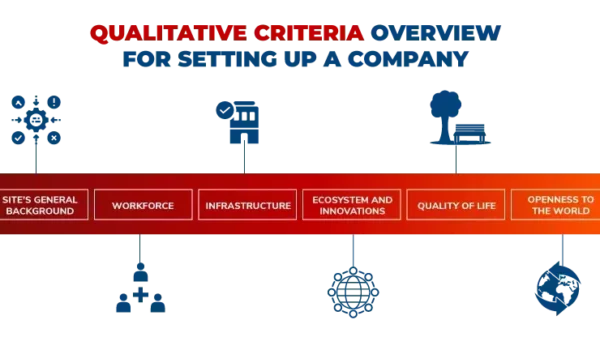Part 1: Introduction
Background and project goals
The background and goals of your business development project are obvious to you, but they won’t always be clear to your local partners.
So when you draft your specifications, be sure to include your “why.”
Your introduction should:
- Provide a brief description of your business and its values
- Summarize your international business development strategy
- Outline your goals for the new site
In the sections that follow, you can list the special needs of your project in detail.
Parts 2 and 3 : Business selection criteria
Overall environment
This section should describe the location you need.
Are you looking for:
- a specific industrial environment
- an area with little urban development
- a site near a major city
- a specific ecosystem
These broad criteria alone will help you eliminate unsuitable regions and narrow the field.
Accessibility
Accessibility is largely a question of logistics:
- What highways, rail, ports, airports and other infrastructures do you need to:
- optimize incoming shipments of raw materials and/or semi-finished products
- ship your finished products out to customers
- What is the maximum desirable distance between these infrastructures and your new site?
Accessibility is also important for your employer brand. It should be easy for your future employees—and visitors from your company’s head office—to reach the site.
Part 4 : Human resources and hiring
Finding a new site also means finding the right labor pool.
In this section, assess your short- and medium-term human resource needs. This includes:
- Total workforce
- Breakdown by job category
- Special skills
- Workforce flexibility
Your partners can help you find a site in a region with strong recruitment potential.
Part 5 : Real estate strategy
So far, your site selection specifications have served primarily to reduce the field to a few targeted regions. Now it’s time to refine your search and focus on your specific needs.
Your real estate strategy will get you a little closer to your ideal site.
- Are you looking for land that you can build on, an existing building, or both?
- Would you rather buy or rent?
- When do you want operations to start up?
At this point, you’ll have narrowed your list of potential sites significantly.
Part 6 : Site description
In this final section, you’ll create a detailed list of the features you want at your new site:
- Size and functional characteristics of the land you need
- General description (including floor area and dimensions) of the building you need
- Breakdown of floor area by type of activity
- Special requirements for industrial operations
- Parking and delivery facilities
- Utilities such as water, gas and electricity







![[TEMPLATE] How business location specifications can make or break your new venture](https://www.nordfranceinvest.com/wp-content/uploads/2024/01/mockup-cdc-site-ideal-ouvert-bureau-fr-aspect-ratio-443-290.png)



